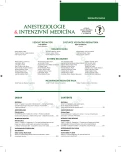Patophysiology and diagnostics of anaphylactic syndrome of pregnancy
Authors:
A. Černý; A. Pařízek; Patrik Šimják
Authors‘ workplace:
Gynekologicko-porodnická klinika Všeobecné fakultní nemocnice a 1. lékařské fakulty Univerzity Karlovy v Praze
Published in:
Anest. intenziv. Med., 26, 2015, č. 5, s. 291-296
Category:
Obstetric anaesthesia and analgesia - Review Article
Overview
Amniotic fluid embolism (also known as anaphylaxis-like syndrome) is a rare but serious pregnancy complication with high mortality. Presentations may vary from subtle clinical events to sudden cardiac arrest or death. Amniotic fluidembolism is one of the most common causes of maternal mortality in developed countries. The basic principle is the entry of amniotic fluid and its particles into maternal circulation. It is hypothesised that these particles trigger an immune-based mechanism. This results in a wide spectrum of clinical symptoms including cardiovascular, respiratory and haematological. The management of these symptoms requires prompt interdisciplinary co-operation. Mortality of AFE has been decreasing in recent times due to increased quality of intensive care and the inclusion of less severe episodes in the perinatal pathology registries.
Keywords:
amniotic fluid embolism – anaphylactic shock – sepsis
Sources
1. Benson, M. D. Current concepts of immunology and diagnosis in amniotic fluid embolism. Clin. Dev. Immunol., 2012, 946576, s. 7.
2. Knight, M., Berg, C., Brocklehurst, P. et al. Amniotic fluid embolism incidence, risk factors and outcomes: a review and recommendations. BMC Pregnancy and Childbirth, 2012, 12, 11 s. Dostupné na www: http://www.biomedcentral.com/1471-2393/12/7.
3. Kobayashi, H., Naruse, K., Sado, T. et al. Search for amniotic fluid-specific markers: novel biomarker candidates for amniotic fluid embolism. The Open Women’s Health Journal, 2011, 5, s. 7–15.
4. Clark, S. L., Hankins, G. D. V., Dudley, D. A. et al. Amniotic fluid embolism: Analysis of the national registry. Am. J. Obstet. Gynecol., 1995, 172, s. 1158–1169.
5. Thongrong, C., Kasemsin, P., Hofmann, J. P. et al. Amniotic fluid embolism. Int. J. Crit. Inj. Sci., 2013, 3, p. 51–57.
6. Tuffnell, D. J. Amniotic fluid embolism. Curr. Opin. Obstet. Gynecol., 2003, 15, s. 119–122.
7. Knight, M., Tuffnell, D., Brocklehurst, P. et al. Incidence and risk factors for amniotic-fluid embolism. Obstet gynecol., 2010, 115, s. 910–917.
8. Kramer, M. S., Rouleau, J., Liu, S. et al. Amniotic fluid embolism: incidence, risk factors, and impact on perinatal outcome. BJOG, 2012, 119, s. 874–879.
9. McDonnell, N. J., Percival, V., Peach, M. J. Amniotic fluid embolism: a leading cause of maternal death yet still a medical conundrum. Int. J. Obstet. Anesth., 2013, 22, s. 329–336.
10. Pařízek, A. Embolie plodovou vodou. In Pařízek, A. Kritické stavy v porodnictví. Kamenice: Mother-Care-Centrum Publishing, 2012, s. 108–110.
11. Tuffnell, D. J. United Kingdom amniotic fluid embolism register. BJOG, 2005, 112, s. 1625–1629.
12. Legrand, M., Rossignol, M., Dreux, S. et al. Diagnostic accuracy of insulin-like growth factor binding-protein-1 for amniotic fluid embolism. Crit. Care Med., 2012, 40, s. 2059–2063.
13. Conde-Agudelo, A., Romero, R. Amniotic fluid embolism: an evidence based review. Am. J. Obstet. Gynecol., 2009, 201, s. 445, e1-445.13.
14. Busardo, F. P., Frati, P., Zaami, S. et al. Amniotic fluid embo-lism patophysiology suggests the new diagnostic armamentarium: β-tryptase and complement fractions C3-C4 are the indispensable working tools. Int. J. Mol. Sci., 2015, 16, p. 6557–6570.
15. Fitzpatrick, K. E., Tuffnell, D., Kurinczuk, J. J. et al. Incidence, risk factors, management and outcomes of amniotic-fluid embolism: a population-based cohort and nested case-control study. BJOG, 2015, 12. Dostupné na www: www.bjog.org.
16. Firstenberg, M. S., Abel, E., Blais, D. et al. Temporary extracorporeal circulatory support and pulmonary embolectomy for catastrophic amniotic fluid embolism. Heart Surg. Forum, 2011, 14, s. 157–159.
17. Dobbenga-Rhodes, Y. A. Responding to amniotic fluid embolism. AORN J., 2009, 89, s. 1079–1088.
18. Bláha, J. Trombembolické příhody v porodnictví. In Hájek, Z.et al. Porodnictví. 3. přepracované a doplněné vydání. Praha: Grada Publishing, a. s., 2014, s. 401–411. ISBN 978-/80-247-4529-9.
Labels
Anaesthesiology, Resuscitation and Inten Intensive Care MedicineArticle was published in
Anaesthesiology and Intensive Care Medicine

2015 Issue 5
Most read in this issue
- Comparison of heparin and citrate anticoagulation during continuous veno-venous haemodialysis (CVVHD) in critically ill children – prospective, crossover study
- Patophysiology and diagnostics of anaphylactic syndrome of pregnancy
- Echocardiography for preload and fluid responsiveness assessment
- Practice advisory on anesthetic care for magnetic resonance imaging
